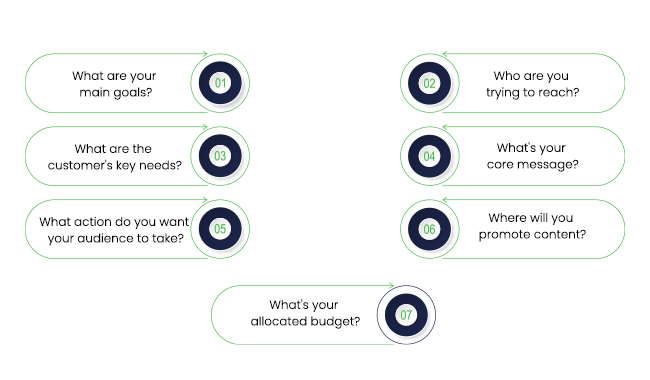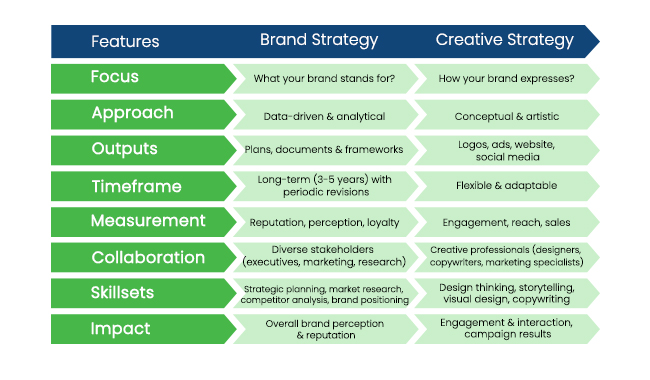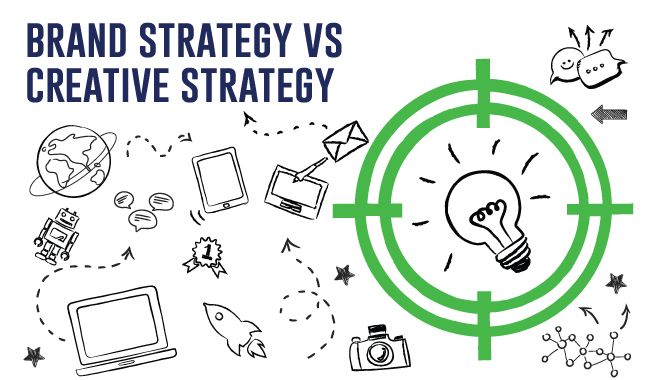Understanding the distinction between Brand Strategy and Creative Strategy is a common query in business, often accompanied by complex responses don’t you think? Different people might give you different explanations, throwing in various marketing terms that might leave you scratching your head. Well, we’re here to make things crystal clear.
Today, let’s talk about what Brand Strategy and Creative Strategy mean and why they matter for your business in this detailed blog.
What Is Brand Strategy?
In the blink of an eye, a logo should captivate—this is where a robust brand strategy steps in. It acts as the compass, guiding businesses through the bustling noise of today’s market. Contrary to what people think branding or brand strategy is not just about the logos or colors. Brand strategy lies as a master plan to shape how a company wants to be remembered and how it wants to be introduced to the world.
A brand strategy is not simple. It involves targeting the target audience, understanding competitors, and crafting a good narrative that resonates. The brand strategy ensures every aspect of a brand – from the products to the communication – aligns seamlessly, developing a memorable experience for consumers. It’s the roadmap that transforms a business from nothing to a recognizable personality in the market.
So, What Goes Into A Brand Strategy?
- Vision: It’s the big picture of what you want your brand to achieve.
- Mission: It’s how you’re going to make your vision a reality.
- Values: Guiding principles and the core beliefs that drive your brand’s decisions.
- Positioning: It’s how you’re going to stand out from the crowd and attract your target audience.
- Voice: It’s the tone and style you use to communicate with your audience.
- Target Audience: A specific group of people the brand is trying to reach and serve.
- Brand Identity: Visual elements like logo, colors, and design that represent the brand.
- Brand Storytelling: The narrative that conveys the brand’s history, values, and mission compellingly.
- Brand Consistency: Maintaining uniformity in messaging, design, and customer experience across all touchpoints.
- Brand Equity: The perceived value and strength of a brand in the eyes of consumers.
Examples Of How Brand Strategy Works:
Here are popular brand strategy examples of brands to get inspired from:
1. Nike
Brand Strategy: Nike’s brand strategy is centered around empowerment and performance.
How They Executed It: Through its “Just Do It” campaign, Nike encourages individuals to push their limits and strive for greatness. By associating the brand with elite athletes and a mindset of accomplishment, Nike positions itself as a symbol of motivation and achievement.
2. Google
Brand Strategy: Google’s brand strategy is rooted in innovation, accessibility, and making information universally available.
How They Executed It: Through products like Google Search, Maps, and Android, Google positions itself as a brand that empowers users with knowledge and simplifies daily tasks. The colorful and playful design elements also contribute to a friendly and approachable brand image.
Enough talking about brand strategy, let’s look at creative strategy
What Is Creative Strategy?

Imagine your Brand strategy as a blueprint to build your house. Once you have your brand strategy in place, it’s time to start decorating your house! This is where your creative strategy comes in. Creative strategy involves a plan for how you’re going to bring your brand to life through your marketing and communication efforts.
How your home decoration needs furniture, paint, and artwork in the house, the creative strategy gives everything a brand deserves and gives your brand a unique look and feel. It’s the tactical execution of your brand strategy, using creativity to communicate your brand message and connect with your target audience. Besides going all into creative strategy, it is better to focus on finding answers to the following questions.

After finding answers to these questions, have a look at the list of what goes into a compelling creative strategy:
So, what goes into a creative strategy?
- Creative concept: The big idea that ties all your creative efforts together.
- Messaging: The key messages you want to communicate.
- Visual identity: The look and feel of your brand, including your logo, colors, fonts, and imagery.
- Marketing channels: The platforms you will use to reach your target audience.
- Creative assets: The specific content you will create to support your campaigns, such as ads, social media posts, and website content
Examples Of How Creative Strategy Works:
Here are some popular creative strategy examples of brands to get inspired:
1.GoPro’s User-Generated Content
Objective: The main goal of GoPro is to showcase the capabilities of GoPro cameras and build a community.
How They Executed It: GoPro encourages users to share their adventures captured on GoPro cameras. This user-generated content serves a dual purpose, it showcases the product’s capabilities in real-world scenarios and builds a community of passionate users. It’s a creative strategy that leverages the authenticity of the user experience.
2. Apple’s Keynote Events
Objective: Apple’s main goal is to generate excitement and anticipation for new product releases.
How They Executed It: Apple’s product launch events are a masterclass in creating anticipation. The company builds suspense, uses sleek visuals, and employs charismatic presenters to showcase new products. By turning product launches into the best experiences, Apple creates a sense of exclusivity and desire among consumers.
3. Wendy’s Twitter Roasts
Objective: Wendy’s goal is to increase brand engagement and create a unique brand voice through their social media channels.
How They Executed It: Wendy’s started engaging with people or people’s posts in a sassy and humorous tone on Twitter often engaging in playful banter and roasting competitors. This strategy not only entertains the audience but also makes Wendy’s stand out in the crowded fast-food landscape, creating a memorable brand personality.
Which Comes First, Brand Strategy or Creative Strategy?
Deciding whether brand strategy or creative strategy comes first is like figuring out the ultimate chicken-or-egg debate for marketers. So here’s the deal. Building a brand is like baking a cake. So, in that case, will you buy for ingredients and then look at the recipe or look at the recipe before buying ingredients? If it’s the second option you are good to go. If you choose the first option, I’m sorry to say this but you aren’t a good baker.
Because you need both the recipe (brand strategy) and the ingredients (creative strategy) to create something delicious and satisfying for your brand. Always remember, that a solid brand strategy is like the plot of your story, and the creative strategy is how you turn those words into a tale that everyone wants to read. They’re the dynamic duo, each bringing something special to your brand.
Similarities Of Brand Strategy And Creative Strategy
Brand strategy and creative strategy are two sides of the same coin, working together to create a strong and successful brand. Although distinct in their functions, both strategies work in perfect harmony to create a powerful and cohesive brand experience. Let’s have a look at where both brand strategy and creative strategy go along so well.
1. Alignment with Vision and Values
Imagine your brand as a ship sailing across the ocean. Both brand strategy and creative strategy act as the compass and the sail, ensuring the ship navigates towards a clear destination while staying true to its core principles.
- Brand strategy defines the goal, outlining the brand’s vision, mission, and core values, and ensuring everyone on board understands the ultimate goal.
- Creative strategy translates the brand’s values into expressions. It utilizes visuals, messaging, and marketing channels to communicate the brand’s essence in a way that resonates with the target audience.
This similarity between brand strategy and creative strategy is important for maintaining consistency and clarity across all touchpoints. Remember that your brand cannot achieve its goals if its strategies are misaligned.
2. Targeting the Right Audience
Finding the right audience is highly important for a brand. Both brand strategy and creative strategy help ensure you attract the ideal target audience.
- Brand strategy defines the type of people to attract, identifying the target audience’s demographics, interests, and pain points. This provides valuable insights into their needs and desires, allowing the brand to tailor its message accordingly.
- Creative strategy attracts them, using compelling visuals, messaging, and marketing channels to entice the target audience. It’s about understanding what resonates with them and crafting communications that address their specific needs and aspirations.
By effectively targeting the right audience, both strategies contribute to building stronger connections and fostering loyal relationships, ultimately driving brand success.
3. Differentiation in the Market
In a crowded marketplace, both brand strategy and creative strategy help the brand stand out from the competition and claim its unique space.
- Brand strategy defines the unique qualities of the brand, highlighting the brand’s competitive advantages and unique selling propositions. It’s about understanding what makes the brand different and valuable in the eyes of the target audience.
- Creative strategy showcases the brand’s distinct beauty, expressing the brand’s personality and differentiating it from competitors through its visual identity, tone of voice, and messaging style.
This focus on differentiation ensures the brand leaves a lasting impression on the target audience and prevents it from being lost in the sea of sameness.
4. Building Brand Identity
Everyone has a distinct personality and style, similarly, your brand should be different from others. Both brand strategy and creative strategy shape this personality and create a strong and consistent brand identity.
- Brand strategy defines the personality traits, outlining the brand’s values, beliefs, and behaviors. It’s about establishing the “who” and “what” of the brand, creating a foundation for its image.
- Creative strategy brings the personality to life, translating the brand’s values into expressions through visuals, messaging, and customer interactions. It’s about the “how” and “what” of the brand.
When both strategies work together, they create a powerful brand identity for building trust and loyalty, ultimately driving brand success.
5. Measurable Success
In terms of measuring success, both brand strategy and creative strategy track progress and measure the effectiveness of your efforts.
- The brand strategy sets measurable goals, outlining key performance indicators (KPIs) to get a framework for evaluating success and making data-driven decisions.
- Creative strategy helps track and analyze the effectiveness of communication efforts. It uses metrics like engagement, reach, and conversions to understand whether the message resonates with the target audience and achieves desired outcomes.
By measuring the success of both strategies, brands can gain valuable insights into what works and what doesn’t. This allows for continuous improvement, ensuring the brand remains relevant and adapts to changing market landscapes and audience preferences.
Brand Strategy vs Creative Strategy
While both brand strategy and creative strategy are crucial for building a successful brand, both have distinct roles and functions. Let’s have a deep look at the difference between brand strategy and creative strategy.

1. Focus
- Brand Strategy: Focuses on the “big picture,” defining the core identity of the brand. It sets the long-term direction through vision, mission, values, target audience, and competitive analysis.
- Creative Strategy: Focuses on the “micro-level”. It aims to bring the brand to life in a way that resonates with the target audience.
2. Approach and Methodology
- Brand Strategy: Employs a data-driven and analytical approach, relying on market research, competitor analysis, and customer insights. It involves strategic planning and decision-making based on gathered information.
- Creative Strategy: Uses a conceptual and artistic approach, relying on creativity, storytelling, and design principles. It involves brainstorming, ideation, and experimentation to develop engaging and impactful brand expressions.
3. Outputs & Deliverables
Brand Strategy: Produces conceptual documents like brand positioning statements, value propositions, brand guidelines, and brand architecture maps. These documents serve as the foundation for future creative happenings.
Creative Strategy: Generates deliverables like logos, advertisements, website design, social media content, and marketing campaigns.
4. Timeframe and Adaptability
- Brand Strategy: Typically has a longer timeframe (3-5 years), with revisions made periodically to reflect evolving market trends and brand goals.
- Creative Strategy: It’s more flexible and adaptable, evolving more frequently to stay relevant in a dynamic environment. It allows for quick adjustments and experimentation based on campaign performance and audience feedback.
5. Measurement
- Brand Strategy: Measured through intangible metrics like brand awareness, brand perception, customer loyalty, and brand equity. These metrics assess the brand’s overall impact and standing in the market.
- Creative Strategy: Measured through tangible metrics like engagement, reach, conversions, campaign performance, and sales. These metrics track the effectiveness of specific campaigns and creative executions.
6. Collaboration
- Brand Strategy: Requires collaboration across various stakeholders within the organization, including executives, marketing teams, brand managers, and research specialists.
- Creative Strategy: Typically involves close collaboration between creative professionals like designers, copywriters, and marketing specialists.
7. Skillsets & Expertise
- Brand Strategy: Requires expertise in strategic planning, market research, competitor analysis, and brand positioning. It involves professionals with a strong analytical and data-driven mindset.
- Creative Strategy: Demands expertise in design thinking, storytelling, visual design, and copywriting. It involves professionals with a strong creative vision and artistic sensibility.
8. Impact and Outcomes
- Brand Strategy: Shapes the overall perception and reputation of the brand. It drives long-term brand growth and sustainability.
- Creative Strategy: Generates engagement and interaction with the target audience. It drives immediate campaign results and short-term brand success.
6 Ways To Master Brand And Creative Strategy
1. Define Your Core Identity
Clearly articulate your brand’s vision, mission, values, and target audience. Translate these core elements into a consistent visual identity, messaging style, and tone of voice.
See how Patagonia’s brand identity reflects its commitment to environmental activism and outdoor adventure. Its logo, messaging, and marketing campaigns consistently reinforce this core value.
2. Conduct Market Research and Competitor Analysis
Understand your target audience’s needs, desires, and pain points. Analyze your competitors’ strengths and weaknesses to identify differentiation opportunities. Tailor your visuals and messaging to resonate with your target audience. Then leverage your selling proposition to stand out from the competition.
Look how Nike’s “Just Do It” campaign effectively taps into the aspirations of athletes and fitness enthusiasts. Their campaigns fuel the emotions of everyone. Even its competitor, Adidas, focuses on its innovation to appeal to a different audience segment.
3. Practice, Iterate, Improve
Practice makes everything perfect. Implement your brand and creative strategies, but don’t stop there. Continuously analyze results, gather feedback, and iterate. The more you apply these strategies and learn from your experiences, the more refined and effective your approach will become.
Coca-Cola’s marketing strategy has evolved over the years. They’ve consistently practiced and refined their approach, adapting to changing consumer preferences while keeping their core brand message of happiness intact.
4. Craft Compelling Stories
Develop a brand narrative that resonates with your audience and reflects your brand values.
Creative Strategy: Create emotional connections through engaging storytelling, interactive experiences, and personalized content. Ensure consistency across all touchpoints, including marketing materials, customer service interactions, and online presence.
Dove’s “Real Beauty” campaign challenged traditional beauty standards and resonated with women of diverse backgrounds. It’s the storytelling approach that helped Dove build a loyal customer base, while its consistent messaging across all platforms reinforces its commitment to inclusivity.
5. Seek Feedback and Stay Open-Minded
Don’t be afraid of feedback. Actively seek input from your team, stakeholders, and even your audience. Stay open-minded and be willing to adapt. The ability to listen, learn, and evolve your strategies based on feedback is important to master the landscape of brand and creative strategy.
Starbucks regularly seeks feedback through social media and customer surveys. They’ve shown the ability to adapt, introducing new products and adjusting their approach based on customer input, keeping their brand fresh and responsive.
6. Measure and Analyze Results
Track key metrics like brand awareness, brand perception, and customer loyalty to measure the effectiveness of your strategy. Analyze campaign performance and engagement data to identify what resonates with your audience and make necessary adjustments.
Netflix continually analyzes user data to personalize its recommendations and improve its content library. This data-driven approach has contributed to its massive subscriber base and global success.
So, there you have it. Now, if you’re thinking about implementing these strategies in your business, consider reaching out to an expert branding and creative agency. So, if you’re ever in need of expert guidance, consider the Go-To Guy! –a top-notch branding and creative agency. Boost your brand game with The Go-To Guy! today, because every brand deserves its moment to shine!
About The Go-To Guy!
The Go-To Guy! is a creative agency that builds memorable brand identities, activates online presence, and enhances brand engagement to help companies grow online, offline, and across multiple platforms.

